美国汽车排放标准文档
carb-epa标准
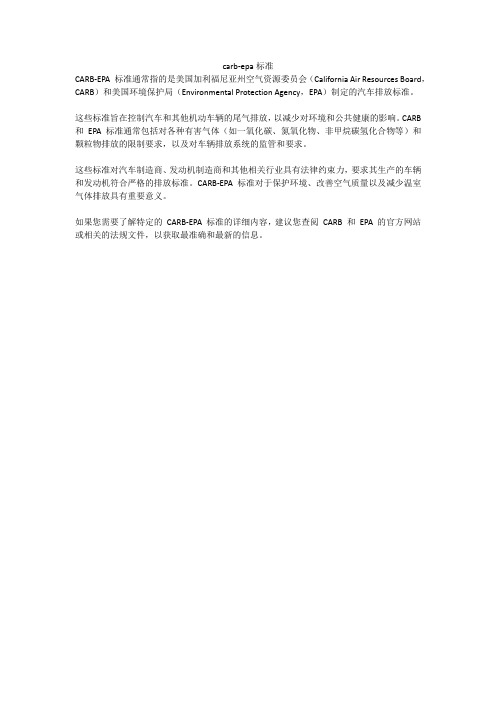
如果您需要了解特定的CARB-EPA标准的详细内容,建议您查阅CARB和EPA的官方网站或相关的法规文件,以获取最准确和最新的信息。
carb-epa标准
CARB-EPA标准通常指的是美国加利福尼亚州空气资源委员会(California Air Resources Board,CARB)和美国环境保护局(Environmental Protection Agency,EPA)制定的汽车排放标准。
这些标准旨在控制汽车和其他机动车辆的尾气排放,以减少对环境和公共健康的影响。CARB和EPA标准通常包括对各种有害气体(如一氧化碳、氮氧化物、非甲烷碳氢化合物等)和颗粒物排放的限制要求,以及对车辆排放系统的ቤተ መጻሕፍቲ ባይዱ管和要求。
tier3排放标准

tier3排放标准
Tier 3排放标准是指美国环保署(EPA)制定的一项严格的汽车尾气排放标准,旨在进一步降低汽车尾气污染物的排放量。
该标准于2017年1月1日开始实施,适用于所有轻型和重型汽油和柴油发动机车辆。
Tier 3排放标准主要针对三种污染物:一氧化碳、非甲烷总烃和氮氧化物。
以下是具体内容:1. 汽油车- 限制一氧化碳(CO)排放量为100毫克/公里
- 非甲烷总烃(NMHC)+NOx 排放量不得超过10毫克/公里
- 要求使用更清洁的汽油,并将硫含量从30ppm降至10ppm以下2. 柴油车- NOx 排放量不得超过0.05克/马力小时
- PM (颗粒物)排放限值下调到6mg/km
- 燃料中硫含量也被大幅度降低至15 ppm以下此外,Tier 3还规定了新的温室气体标准,包括二氧化碳、甲烷和其他挥发性有机化合物等。
这些措施可以帮助改善空气质量并保护人类健康。
虽然Tier 3对汽车厂商来说可能会增加成本,但它也促使他们开发更先进、更环保的技术以满足新标准。
同时,消费者也能享受到更清洁、更高效、更安全的交通工具。
综上所述,Tier 3是一个重要而必要的举措,在全球范围内推广应用可以有效地改善空气质量,并为未来创造一个可持续发展环境。
epa21排放标准
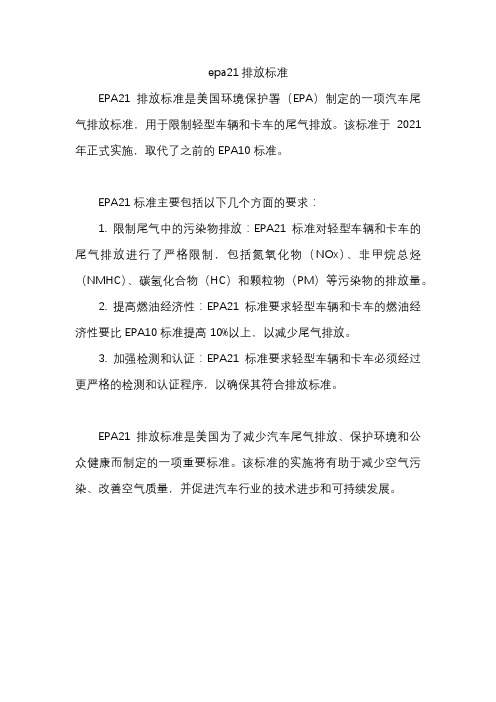
epa21排放标准
EPA21 排放标准是美国环境保护署(EPA)制定的一项汽车尾气排放标准,用于限制轻型车辆和卡车的尾气排放。
该标准于2021 年正式实施,取代了之前的 EPA10 标准。
EPA21 标准主要包括以下几个方面的要求:
1. 限制尾气中的污染物排放:EPA21 标准对轻型车辆和卡车的尾气排放进行了严格限制,包括氮氧化物(NOx)、非甲烷总烃(NMHC)、碳氢化合物(HC)和颗粒物(PM)等污染物的排放量。
2. 提高燃油经济性:EPA21 标准要求轻型车辆和卡车的燃油经济性要比 EPA10 标准提高 10%以上,以减少尾气排放。
3. 加强检测和认证:EPA21 标准要求轻型车辆和卡车必须经过更严格的检测和认证程序,以确保其符合排放标准。
EPA21 排放标准是美国为了减少汽车尾气排放、保护环境和公众健康而制定的一项重要标准。
该标准的实施将有助于减少空气污染、改善空气质量,并促进汽车行业的技术进步和可持续发展。
美国汽车排放标准
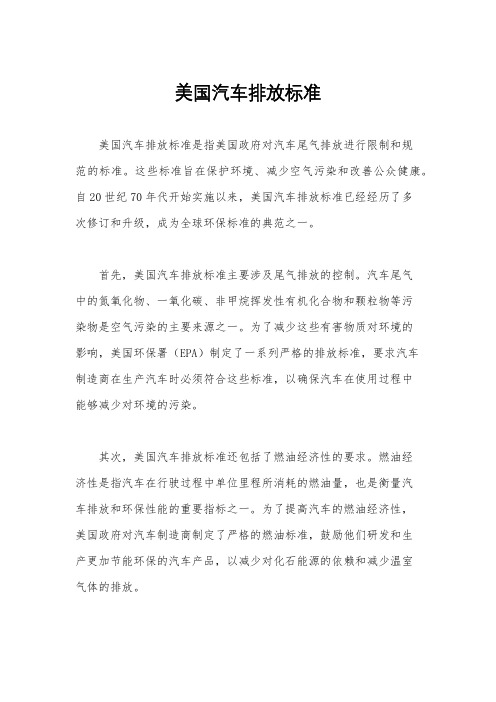
美国汽车排放标准美国汽车排放标准是指美国政府对汽车尾气排放进行限制和规范的标准。
这些标准旨在保护环境、减少空气污染和改善公众健康。
自20世纪70年代开始实施以来,美国汽车排放标准已经经历了多次修订和升级,成为全球环保标准的典范之一。
首先,美国汽车排放标准主要涉及尾气排放的控制。
汽车尾气中的氮氧化物、一氧化碳、非甲烷挥发性有机化合物和颗粒物等污染物是空气污染的主要来源之一。
为了减少这些有害物质对环境的影响,美国环保署(EPA)制定了一系列严格的排放标准,要求汽车制造商在生产汽车时必须符合这些标准,以确保汽车在使用过程中能够减少对环境的污染。
其次,美国汽车排放标准还包括了燃油经济性的要求。
燃油经济性是指汽车在行驶过程中单位里程所消耗的燃油量,也是衡量汽车排放和环保性能的重要指标之一。
为了提高汽车的燃油经济性,美国政府对汽车制造商制定了严格的燃油标准,鼓励他们研发和生产更加节能环保的汽车产品,以减少对化石能源的依赖和减少温室气体的排放。
此外,美国汽车排放标准还涉及到汽车的尾气排放控制技术。
为了满足排放标准的要求,汽车制造商需要在汽车上安装先进的排放控制设备,如三元催化转化器、颗粒物过滤器等,以净化汽车尾气中的有害物质,降低对环境的影响。
同时,美国政府还鼓励汽车制造商采用新能源汽车技术,如电动汽车、混合动力汽车等,以进一步减少汽车尾气排放对环境的影响。
总的来说,美国汽车排放标准是一项重要的环保政策,对于减少空气污染、改善环境质量、保护公众健康具有重要意义。
通过严格的排放标准、燃油经济性要求和先进的排放控制技术,美国汽车排放标准不仅推动了汽车工业的技术进步和创新,也为全球环保事业树立了榜样。
相信在未来,美国汽车排放标准将继续发挥重要作用,推动汽车工业向更加环保、可持续的方向发展,为人类创造一个更加清洁、健康的生活环境。
美国汽车排放标准
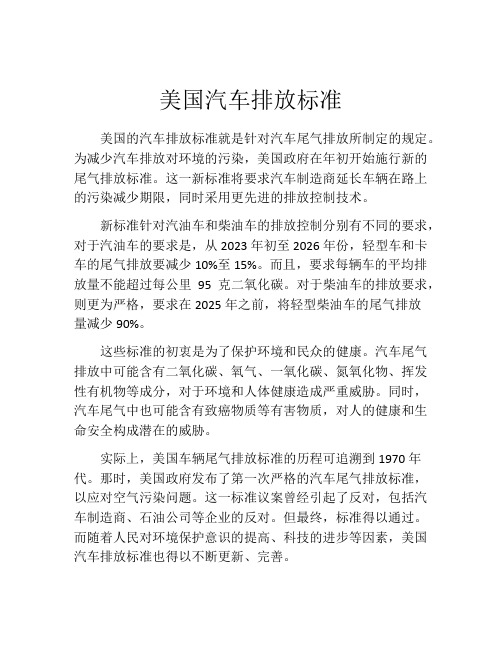
美国汽车排放标准美国的汽车排放标准就是针对汽车尾气排放所制定的规定。
为减少汽车排放对环境的污染,美国政府在年初开始施行新的尾气排放标准。
这一新标准将要求汽车制造商延长车辆在路上的污染减少期限,同时采用更先进的排放控制技术。
新标准针对汽油车和柴油车的排放控制分别有不同的要求,对于汽油车的要求是,从2023年初至2026年份,轻型车和卡车的尾气排放要减少10%至15%。
而且,要求每辆车的平均排放量不能超过每公里95克二氧化碳。
对于柴油车的排放要求,则更为严格,要求在2025年之前,将轻型柴油车的尾气排放量减少90%。
这些标准的初衷是为了保护环境和民众的健康。
汽车尾气排放中可能含有二氧化碳、氧气、一氧化碳、氮氧化物、挥发性有机物等成分,对于环境和人体健康造成严重威胁。
同时,汽车尾气中也可能含有致癌物质等有害物质,对人的健康和生命安全构成潜在的威胁。
实际上,美国车辆尾气排放标准的历程可追溯到1970年代。
那时,美国政府发布了第一次严格的汽车尾气排放标准,以应对空气污染问题。
这一标准议案曾经引起了反对,包括汽车制造商、石油公司等企业的反对。
但最终,标准得以通过。
而随着人民对环境保护意识的提高、科技的进步等因素,美国汽车排放标准也得以不断更新、完善。
此外,美国环保署也积极推动环境法规的制定和执行,对于汽车制造商和车主都提出了更高的要求。
例如,美国1970年颁布的《国家环境政策法案》,将环境保护列为国家政策目标之一,并鼓励实行环境审批的制限措施。
美国在环境保护方面一直走在全球的前列,其推动环保措施的力度和效果也受到业内的高度认可。
而在汽车尾气排放标准方面,也一直处于全球领先水平。
不断更新、完善的汽车尾气排放标准,让消费者拥有更加环保、节能的汽车产品选择,同时也为保护环境和民众的健康发挥了重要作用。
国标、欧标、美标排放对比

整车 瞬态 汽油 柴油 11.007 1180 120 33.6 160000
整车 瞬态 汽油 柴油 23.26 1800 131.6 46.3 160000
整车 瞬态 汽油 柴油 11.007 1180 120 33.6 160000
整车 瞬态 汽油 柴油 23.26 1800 131.6 46.3 160000
低排放汽车排放标准 LEV1 TLEV LEV ULEV ZEV 1 1 1 1
2阶段 LEV2 LEV ULEV 2 2 SULE ZEV2 V2
日本
10/15工况 11工况
10/15工况+11工况循环 标准 欧盟 1993 欧1 1996 欧2
10/15工况+11工况循环 2000/2002标准
实施日期
2015 ?? 2015 ?? 2015 ?? 2015 ?? 2015 ?? 2015 ??
CO 0.50 0.50 1.0 1.0 0.63 0.63 1.81 1.81 0.74 0.74 2.27 2.27
HC 一 一 0.1 0.1 一 一 0.13 0.13 一 一 0.16 0.16
V1
动力链工作小组 吴昌圣
9
内部文件,注意保密
谢 谢!
V1
动力链工作小组 吴昌圣
10
四.各体系排放限值
美国 SU——轻型车 ≤12座的轻型车 限值单位是克/英里 限值单位是克/千米
内部文件,注意保密
1)到2003的柴油车允许1.0/1.25g/英里(mi)的NOx排放
3)非甲烷有机气体(NMOG)代替非甲烷碳氢
2011 欧5+ 2012 欧6
欧洲
13工况 ESC循环+ ELR+ETC循 环
美国机动车排放标准
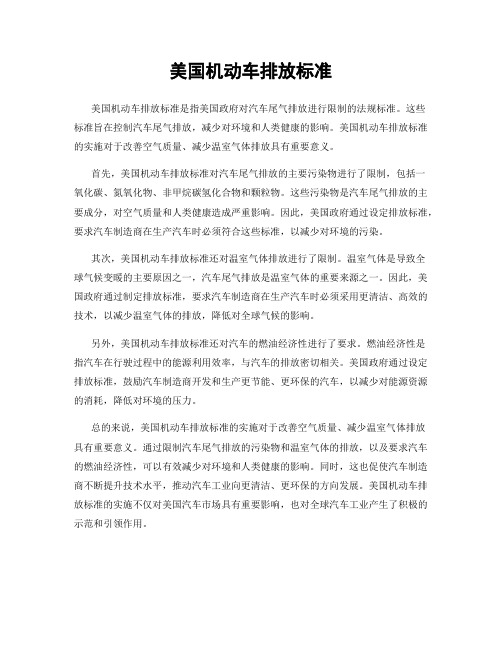
美国机动车排放标准美国机动车排放标准是指美国政府对汽车尾气排放进行限制的法规标准。
这些标准旨在控制汽车尾气排放,减少对环境和人类健康的影响。
美国机动车排放标准的实施对于改善空气质量、减少温室气体排放具有重要意义。
首先,美国机动车排放标准对汽车尾气排放的主要污染物进行了限制,包括一氧化碳、氮氧化物、非甲烷碳氢化合物和颗粒物。
这些污染物是汽车尾气排放的主要成分,对空气质量和人类健康造成严重影响。
因此,美国政府通过设定排放标准,要求汽车制造商在生产汽车时必须符合这些标准,以减少对环境的污染。
其次,美国机动车排放标准还对温室气体排放进行了限制。
温室气体是导致全球气候变暖的主要原因之一,汽车尾气排放是温室气体的重要来源之一。
因此,美国政府通过制定排放标准,要求汽车制造商在生产汽车时必须采用更清洁、高效的技术,以减少温室气体的排放,降低对全球气候的影响。
另外,美国机动车排放标准还对汽车的燃油经济性进行了要求。
燃油经济性是指汽车在行驶过程中的能源利用效率,与汽车的排放密切相关。
美国政府通过设定排放标准,鼓励汽车制造商开发和生产更节能、更环保的汽车,以减少对能源资源的消耗,降低对环境的压力。
总的来说,美国机动车排放标准的实施对于改善空气质量、减少温室气体排放具有重要意义。
通过限制汽车尾气排放的污染物和温室气体的排放,以及要求汽车的燃油经济性,可以有效减少对环境和人类健康的影响。
同时,这也促使汽车制造商不断提升技术水平,推动汽车工业向更清洁、更环保的方向发展。
美国机动车排放标准的实施不仅对美国汽车市场具有重要影响,也对全球汽车工业产生了积极的示范和引领作用。
汽车排放标准
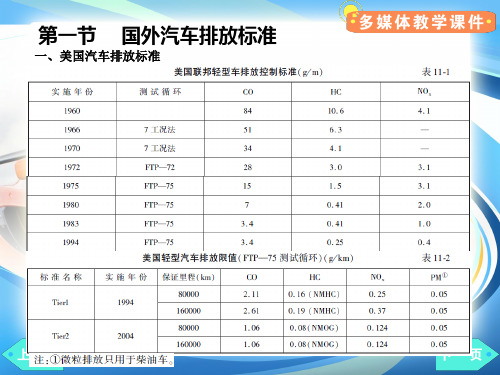
第二节 我国汽车排放标准
第二节 我国汽车排放标准
七、国5 和国6 排放标准
第一节 国外汽车排放标准
第一节 国外汽车排放标准
第二节 我国汽车排放标准
一、1993 年颁布的排放标准 1. 轻型汽车排气污染物排放标准(GB 14761. 1—1993)
第二节 我国汽车排放标准
2. 汽油车怠速污染物排放标准(GB 14761. 5—1993)
二、1993 年北京市颁布的汽车排放标准
2. 压燃式发动机和装用压燃式发动机的车辆排气污染物限值(GB 1769 1—1999)见表11 ̄26。
第二节 我国汽车排放标准
四、2001 年颁布的排放标准
其车辆型式认证Ⅰ型试验与生产一致性检查Ⅰ型试验的排放限值见表11 ̄ 27 与表11 ̄28。
第二节 我国汽车排放标准
第二节 我国汽车排放标准
第二节 我国汽车排放标准
三、1999 年颁布的排放标准 1. 汽车排放污染物限值及测试方法(GB 14761—1999)
其排放限值执行日期及限值见表11 ̄22 ~ 表11 ̄25。
第二节 我国汽车排放标准
第二节 我国汽车排放标准
燃用柴油的M1 和N2 车辆(C 类认证)见表11 ̄25。
第二节 我国汽车排放标准
五、2002 年颁布的排放标准 标准规定了点燃式发动机两个实施阶段的型式核准和生产一致性检查试验
的排放限值和测量方法,见表11 ̄29、表11 ̄30。
第二节 我国汽车排放标准
第二节 我国汽车排放标准
六、2005 年颁布的排放标准
标准规定每次试验测得的气态排放物质量,以及压燃式发动机汽车的颗粒 物质量,都必须低于表11 ̄31 所示限值。表11 ̄32 为Ⅵ型试验(低温试 验)的排放限值。 型式核准的执行日期见表11 ̄33。
美国排放标准

中型乘用车,第二阶段排放标准从 2008 年开始逐步执行,并在 2009 年开始全面执行。在 2004-2007 年的逐步执行期间,未达到第二阶段初步排放标准的所有乘用车和小型轻型载重 车必须达到氮氧化物排放为 0.30 克/英里的临时平均标准(相当于“国家低排放汽车”项目 对于轻型汽车的排放标准)。在 2004-2008 年期间,未达到第二阶段最终排放标准的大型轻 型载重车和中型乘用车逐步执行一个临时项目:氮氧化物的平均排放标准为 0.20 克/英里; 在逐步执行的临时项目之外的汽车执行每辆汽车排放标准(即排放“上限”):大型轻型载 重车的氮氧化物排放标准为 0.60 克/英里,中型乘用车的氮氧化物排放标准为 0.90 克/英里。
表一 美国环保局第一阶段乘用车和轻型载重车排放标准,联邦试验规程,克/英里
类别
50000 英里/5 年
100000 英里/10 年 1
THC NMHC CO NOx† NOx PM 柴油 汽油
THC NMHC CO NOx† NOx PM 柴油 汽油
乘用车
0.41 0.25 3.4 1.0 0.4 0.08 -
第二阶段排放标准分为不同严格程度的八个认证等级以及一个氮氧化物排放的平均车队标 准。汽车制造商在认证具体车型时可任意选择八个等级之一。同时,每家汽车制造商所销售 整个车队的平均氮氧化物排放必须达到 0.07 克/英里的平均标准。过渡期有排放限值更加宽 松的附加临时认证等级(第九等级、第十等级和中型乘用车等级)。这些等级在 2008 之后 终止。
美国排放法规Tier2介绍

乘用车和轻型载重车-Tier 2 简介与Tier 1尾气排放标准相比,Tier 2设立了更多严格的规定,并针对于大型车辆设定了更加严格的标准。
Tier 2规定,相同的排放标准应用于各种重量级别的车辆,即,汽车、小型货车以及轻型卡车和SUV 都采用相同的排放限制。
在Tier 2中,轻型车的排放标准也适用于一些重型车辆。
Tier 1标准适用于重量在8500 lbs 以上GVWR 的车辆,而Tier 2 标准不仅涵盖了Tier 1标准的适用范围,还包括了中型乘用车(MDPV)。
这些中型乘用车是车辆分类中的新类别,重量定位在8500到10000 lbs GVWR,一般为私人使用。
这一类别主要包括大型SUV 车辆和乘用车。
表1略述和定义了Tier 2标准中EPA 中车辆的类别。
重量在8500 lbs GVWR 以上的商用车(货车及轻型卡车)发动机将继续执行重型发动机排放标准。
表1EPA Tier 2标准中规定的车辆类别 轻型车辆 LDV 最大8500 lb GVWRLDT max. 8500 lb GVWR,max. 6000 lb 遏制重量及最大45 ft 2迎风面积LLDT 最大6000 lb GVWR轻型卡车1LDT1最大3750 lb LVW 1超轻型卡车 轻型卡车2LDT2最小3750 lb LVW 1HLDT 最小 6000 lb GVWR轻型卡车3LDT3最大 5750 lb ALVW 2轻型卡车重轻型卡车 轻型卡车4LDT4最小5750 lb ALVW 2中型乘用车MDPV 最大10000 lb GVWR 31 – LVW(负载车重)= 遏制重量 + 300 lb2 – ALVW(经过调整的负载车重)= GVWR 和遏制重量的平均值3 -制造商可以遵照重型柴油发动机的排放规定,为柴油燃料MDPV 选择发动机。
无论车辆使用何种燃料,同样的排放限制适用于所有车辆。
也就是说,使用汽油、柴油或其它替代燃料的车辆都应满足相同的排放标准。
美国柴油机排放法规译文
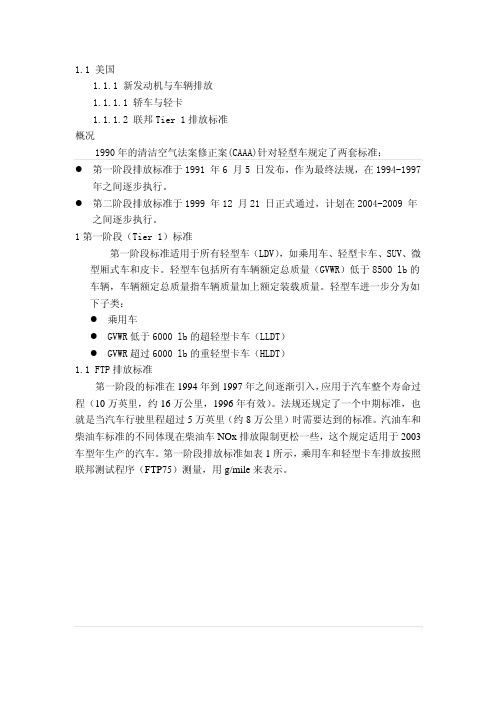
表 #
中间寿命(5 年/50,000 英里)
NMOG
CO NOx PM HCHO
NMOG
可用年限 CO NOx* PM
HCHO
临时标准
MDPVc
0.280
7.3 0.9 0.12 0.032
10a,b,d,f
0.125 (0.160)
3.4 0.4 -
同样的排放标准适用于所有发动机,而不管使用什么燃料。也就是说,使用 汽油、柴油或替代燃料的汽车都必须达到同样的标准。
第二阶段法规对燃油质量提出了要求,必须提供更加清洁的燃料以使先进的 尾气排放处理设备(比如催化剂和颗粒过滤器)正常工作,从而使尾气排放达到 标准。
z 汽油含硫量-从 2004 年开始,项目要求大部分炼油厂和进口商达到企业平 均汽油含硫量为 120ppm 和最高汽油含硫量为 300ppm 的标准。从 2006 年起, 企业平均汽油含硫量和最高含硫量的标准分别减至 30ppm 和 80ppm。对于一 些小型炼油厂,较为宽松的临时标准可以适用到 2007 年。另外,在 2004-2006 年期间,较为宽松的临时标准适用于美国西部的局部地区。
轻型卡车 2 LDT2 最小 3750 lb LVW1
重轻型卡车
HLDT 最小 6000 lb GVWR
轻型卡车 3 LDT3 最大 5750 lb ALVW2
轻型卡车 4 LDT4 最小 5750 lb ALVW2
中型乘用车
MDPV 最大 10000 lb GVWR3
1.LVW:车辆装载后总质量(整备质量+300 lb) 2.ALVW:调整后的 LVW(整备质量和 GVWR 的平均值) 3.制造商可以遵照重型柴油发动机的排放规定,为柴油燃料 MDPV 选择 发动机。
美国联邦机动车排放标准
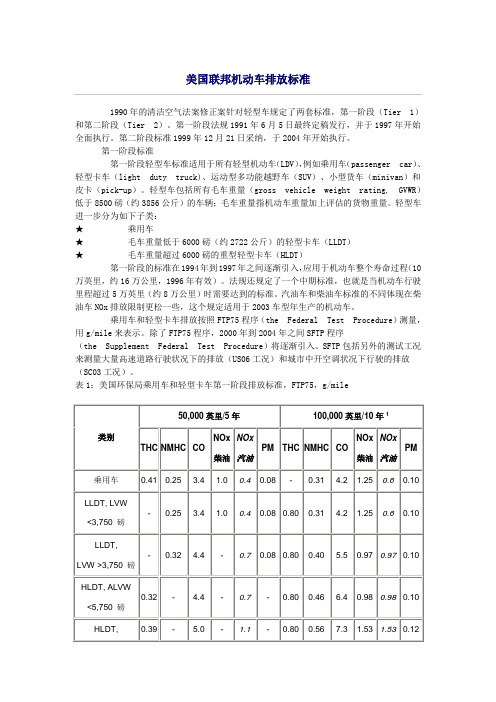
美国联邦机动车排放标准1990年的清洁空气法案修正案针对轻型车规定了两套标准,第一阶段(Tier 1)和第二阶段(Tier 2)。
第一阶段法规1991年6月5日最终定稿发行,并于1997年开始全面执行。
第二阶段标准1999年12月21日采纳,于2004年开始执行。
第一阶段标准第一阶段轻型车标准适用于所有轻型机动车(LDV),例如乘用车(passenger car)、轻型卡车(light duty truck)、运动型多功能越野车(SUV)、小型货车(minivan)和皮卡(pick-up)。
轻型车包括所有毛车重量(gross vehicle weight rating, GVWR)低于8500磅(约3856公斤)的车辆;毛车重量指机动车重量加上评估的货物重量。
轻型车进一步分为如下子类:★乘用车★毛车重量低于6000磅(约2722公斤)的轻型卡车(LLDT)★毛车重量超过6000磅的重型轻型卡车(HLDT)第一阶段的标准在1994年到1997年之间逐渐引入,应用于机动车整个寿命过程(10万英里,约16万公里,1996年有效)。
法规还规定了一个中期标准,也就是当机动车行驶里程超过5万英里(约8万公里)时需要达到的标准。
汽油车和柴油车标准的不同体现在柴油车NOx排放限制更松一些,这个规定适用于2003车型年生产的机动车。
乘用车和轻型卡车排放按照FTP75程序(the Federal Test Procedure)测量,用g/mile来表示。
除了FTP75程序,2000年到2004年之间SFTP程序(the Supplement Federal Test Procedure)将逐渐引入。
SFTP包括另外的测试工况来测量大量高速道路行驶状况下的排放(US06工况)和城市中开空调状况下行驶的排放(SC03工况)。
表1:美国环保局乘用车和轻型卡车第一阶段排放标准,FTP75,g/mile国家LEV项目1997年12约16日,美国环保局确定了国家低排放机动车项目(NLEV)的法规(63 FR 926,7 Jan 1998)。
美国汽车尾气排放标准

美国汽车尾气排放标准美国作为世界上最大的汽车消费市场之一,其汽车尾气排放标准一直备受关注。
汽车尾气排放标准是指汽车在运行时产生的废气中所含有的有害物质的排放限制。
这些有害物质包括一氧化碳、氮氧化物、非甲烷挥发性有机化合物和颗粒物等,它们对人体健康和环境都具有一定的危害性。
因此,各国都制定了相应的汽车尾气排放标准,以保护环境和人类健康。
美国的汽车尾气排放标准由环保署(EPA)制定和执行。
根据美国《清洁空气法》的规定,环保署定期修订和发布汽车尾气排放标准,以限制汽车尾气中有害物质的排放。
这些标准通常分为两类,一类是针对轻型汽车和轻型货车的排放标准,另一类是针对重型车辆(包括卡车和公共汽车)的排放标准。
针对轻型汽车和轻型货车的排放标准,美国环保署制定了一系列严格的排放限制。
其中包括对一氧化碳、氮氧化物、非甲烷挥发性有机化合物和颗粒物等有害物质的排放限制。
此外,环保署还规定了汽车制造商必须在车辆上安装催化转化器等排放控制装置,以确保汽车在使用过程中能够达到相应的排放标准。
对于重型车辆的排放标准,美国环保署同样制定了严格的限制要求。
重型车辆通常搭载更大排量的发动机,因此其排放量也更大。
为了控制重型车辆的排放,环保署规定了更为严格的排放标准,并要求车辆制造商在车辆上安装颗粒物过滤器等排放控制装置,以降低颗粒物的排放量。
除了针对传统燃油车辆的排放标准外,美国环保署还制定了一系列针对新能源汽车的排放标准。
随着电动汽车和混合动力汽车的逐渐普及,环保署也对这些新型车辆的排放进行了规范,以确保它们在使用过程中不会对环境造成额外的污染。
总的来说,美国汽车尾气排放标准的制定和执行,对于保护环境和人类健康起到了积极的作用。
通过严格的排放标准,汽车的尾气排放得到了有效的控制,大大减少了有害物质对环境和人体健康的危害。
未来,随着科技的不断进步和环保意识的提高,相信美国的汽车尾气排放标准会继续得到完善,为建设更加清洁和健康的环境作出更大的贡献。
usepa排放标准
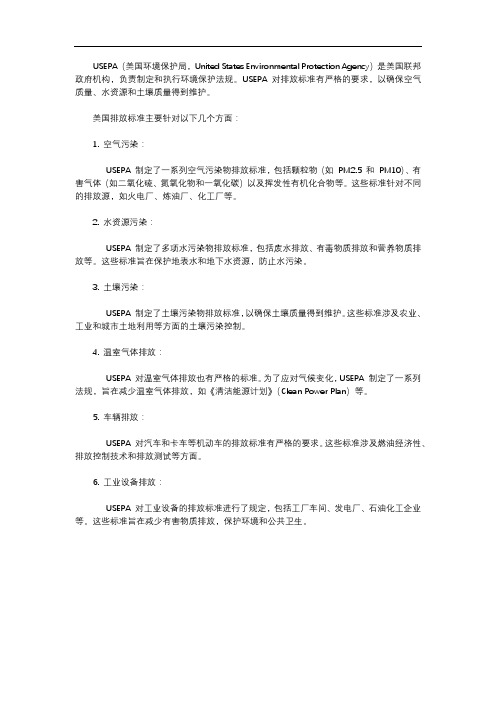
USEPA(美国环境保护局,United States Environmental Protection Agency)是美国联邦政府机构,负责制定和执行环境保护法规。
USEPA 对排放标准有严格的要求,以确保空气质量、水资源和土壤质量得到维护。
美国排放标准主要针对以下几个方面:
1. 空气污染:
USEPA 制定了一系列空气污染物排放标准,包括颗粒物(如PM2.5 和PM10)、有害气体(如二氧化硫、氮氧化物和一氧化碳)以及挥发性有机化合物等。
这些标准针对不同的排放源,如火电厂、炼油厂、化工厂等。
2. 水资源污染:
USEPA 制定了多项水污染物排放标准,包括废水排放、有毒物质排放和营养物质排放等。
这些标准旨在保护地表水和地下水资源,防止水污染。
3. 土壤污染:
USEPA 制定了土壤污染物排放标准,以确保土壤质量得到维护。
这些标准涉及农业、工业和城市土地利用等方面的土壤污染控制。
4. 温室气体排放:
USEPA 对温室气体排放也有严格的标准。
为了应对气候变化,USEPA 制定了一系列法规,旨在减少温室气体排放,如《清洁能源计划》(Clean Power Plan)等。
5. 车辆排放:
USEPA 对汽车和卡车等机动车的排放标准有严格的要求。
这些标准涉及燃油经济性、排放控制技术和排放测试等方面。
6. 工业设备排放:
USEPA 对工业设备的排放标准进行了规定,包括工厂车间、发电厂、石油化工企业等。
这些标准旨在减少有害物质排放,保护环境和公共卫生。
美国联邦和各州机动车排放标准(State and Federal StandardS For mobile source emissions)

S tate and F ederal S tandardS ForM obile S ource e MiSSionSMarch 2006Manufacturers of cars, trucks, and other engines are required to meet emissions standards for the equipment they sell as part of reducing air pollution under the Clean Air Act. The basis for California’s emissions standards, which are generally tougher than federal standards, are scientifically valid. California continues to play a pioneering role in setting mobile source emissions standards that help curb the state’s persistent air pollution and act as a proving ground for new emissions-control technologies. However, implementation of standards could be improved, including speeding up the federal waiver process and strengthening the process by which another state is allowed to opt-in to the California standards.Emissions from fuel-powered mobile sources—including cars, trucks, heavy duty trucks, large construction equipments, lawn mowers, and other small hand-held gardening tools—contribute significantly to air pollution in the United States. Emissions controls for passenger cars and trucks first introduced in the 1960s have substantially reduced emissions, primarily through the development of cleaner engine and fuel technologies. In 2004, per-mile exhaust emissions of new cars and trucks had been reduced by 95-99% compared to 1967 model-year vehicles. However, continuing air quality problems in manylocations in the country means that air qualitymanagers will look to further reduce emissionsfrom mobile sources, including vehicles, in the future.The federal Clean Air Act establishes the framework for controllingp mobile-source emissions, including emissions standards. During the development of the Clean Air Act in 1967, Congress recognized that having too many different state standards could result in inefficiencies in vehicle markets. Therefore, state-established emissions standards were preempted by federal emissions standards. A special exemption was made for California because the state’s air pollution was more severe than in the rest of the nation, and the state had a long history of establishing its own emissions standards for on-road vehicles. TheClean Air Box 1. How Mobile Sources Affect Air Quality Reducing mobile-source emissions plays a key role in attaining the goals outlined inthe Clean Air Act and reducing pollutants that contribute to poor air quality. Mobile sources emit hydrocarbons, nitrogen oxides, particu -late matter, and carbon monoxide, as well as greenhouse gases and hazardous air pollut -ants (HAPs). The volume and composition of emissions from mobile sources depend on such factors as engine type and age, engine load, engine temperature, emission controls, and quality of maintenance. The contribution of mobile-source emissions to air pollution varies from area to area due to factors like the relative mix of sources, the extent of pollutant transport, meteorology, and topography of the area.Act Amendments of 1977 gave other states the option to adopt California emissions standards instead of the federal standards.The role of state versus federal government in es-tablishing mobile-source emissions standards remains an important environmental management issue. For California and other state decision makers, the primary consideration is the level of emissions benefits a stan-dard will produce and how much it will cost residents. In response to a request of Congress, the US Environ-mental Protection Agency (EPA) asked the National Academies to conduct an independent study on the practices and procedures by which California devel-ops its mobile-source emissions standards and other states adopt California standards. State and Federal Standards for Mobile Source Emissions compares the scientific and technical practices used by states to de-velop or adopt emissions standards with those used by EPA, reviews why states outside of California decide to adopt California’s more stringent emissions standards, and assesses the impacts of California emissions stan-dards on an array of factors including compliance costs and air pollutant emissions. California’s Role in Mobile-Source Emis-sions RegulationCalifornia sets its own mobile-source emissions standards through the actions of the California Air Re-sources Board (CARB). California has used its authority as Congress envisioned: to implement more aggressive measures than the rest of the country and to serve as a laboratory for technological innovation. California’s standards are typically stricter than federal standards, in part because they include goals for reducing emissions for some of the state’s most populated and worst pol-luted regions, including the Los Angeles area and the San Joaquin valley. The state has typically led EPA in establishing emissions standards on light-duty vehicles and small nonroad gasoline engines, while EPA has led California in establishing standards for on-road heavy-duty diesel vehicles and off-road diesel engines.The mobile-source emissions standards devel-oped by California and EPA have typically been “tech-nology forcing,” that requires manufacturers to achieve an emissions limit through use of unspecified technol-ogy or technologies that have not yet been developed for widespread commercial applications and have been shown to be feasible on an experiment or pilot-dem-onstration basis. In forcing technology development, California has been a laboratory for emission-control innovations.California’s authority to set its own mobile-source emissions standards imposes additional risks and costs, such as design, production, and distribution costs, although the costs and benefits are difficult to quantify. However, experience to date shows that the California program has been beneficial overall for air quality. California’s pioneering role in setting mobile-source emissions standards will aid the state’s efforts to achieve air quality goals and will allow it to continue to be a proving ground for new emission-control technol-ogies that benefit California and the rest of the nation.I mproving EPA’s Waiver ProcessEach time California sets or substantially revis-es a mobile-source emissions standard, it must seek a waiver from EPA. The waiver review process can take several years and significant EPA resources to complete, even for relatively straightforward and uncontroversial waivers. In some cases, waivers have been approved after vehicles and engines that meet the standards are already in the market, creating uncertainty for Califor-nia, states considering adopting California standards, and manufacturers.To provide timelier waiver decisions for Cali-fornia emissions standards, EPA could establish aTable 1. Major Differences Between How EPA and California Set Mobile Emissions StandardsEPA CaliforniaRule-making Oversight Subject to federal requirements definedin multiple acts and executive orders;overseen by Office of Management andBudget because emissions standardsregulations typically deemed “signifi-cant” Subject to state laws and to oversight by Cali-fornia Office of Administrative LawEconomic Analysis Required to perform cost-benefit analy-sis to estimate monetary benefits ofimproved air quality to public health Required to perform various California-spe-cific economic impact assessmentsEstimating Air Quality Effects In recent years, EPA assessed the airquality impacts of its major mobile-source emissions standards individuallyAir quality impacts of a set of emissions-con-trol strategies are analyzed within the stateimplementation plans (SIPs). SIPs describethe programs a state will use to carry out itsresponsibilities under the CAA for complyingwith ambient air quality standards.Estimating Public Health Effects Required to assess public health effectsand estimate monetary benefitsDoes not directly consider public health ben-efits in regulatory analysis of emissions stan-dards because it uses its proposed standards toattain health-based NAAQS, which EPA hasalready assessed for public health benefitsCoverage of Cost and Ben-efit Analysis Accounts for costs and benefits forentire nationConsiders only costs and benefits of its stan-dards in its jurisdiction and not in other statesthat might later adopt its standardsPublic Involvement Emissions standards subject to lengthypublic-comment and technical-reviewperiods; issued through final notice inFederal Register Adopts emissions standards regulations in a public meeting with a public vote by board members. Public comments during this hear-ing can result in modifications to final stan-dards. California may also include require-ments for periodic review of standards during which standards can be modified.two-track system waiver process. EPA could expedite waiver requests that it considers noncontroversial, ap-proving the waiver without a full notice-and-comment process. The final decision would be published in the Federal Register, and if any interested party raises a substantive objection to the decision, it would be withdrawn and subjected to the full waiver process. This expedited process would allow EPA to process noncontroversial waiver requests quickly and effi-ciently.In addition, a mandatory time limit for EPA to review and issue a waiver decision for controversial waiver requests could be considered based on existing timetables for the EPA waiver process. California is re-quired to provide at least two years between adoption of state regulations and their implementation; a time limit of two years or less for EPA review would fit in that timetable. Comparing Federal and California Regula-tory ProcessesIt is important for states considering which stan-dards to adopt to understand the similarities and dif-ferences between how EPA and California set mobile-source emissions. There are important similarities, including how these agencies assess technological fea-sibility, costs, and emissions impacts. EPA and Cali-fornia also have essentially the same starting point and motivation for setting new or stricter standards—at-tainment of ambient air quality standards mandated by the Clean Air Act. Each agency follows a series of procedural steps leading to a final regulation, includ-ing identifying the need for new emissions standards, evaluating potential control strategies, publicizing pro-posed regulations, and soliciting public comments on proposals before promulgating the regulations. ButCommittee on State Practices in Setting Mobile Source Emissions Standards: David Allen (Chair ), Univer -sity of Texas, Austin, Texas; John Bailar, III , University of Chicago (Retired), Washington, DC; Hugh Ellis , Johns Hopkins University, Baltimore, Maryland; Alison Geyh , Johns Hopkins School of Public Health, Balti -more, Maryland; David Greene , Oak Ridge National Laboratory, Knoxville, Tennessee; James Lents , Univer -sity of California, Riverside, Riverside, California; Gary Marchant , Arizona State University, Tempe, Arizona; Virginia McConnell , Resources for the Future, Inc., Washington, DC; Alison Pollack , ENVIRON International Corporation, Novato, California; Harold Schock , Michigan State University, East Lansing, Michigan; Karl Springer , Southwest Research Institute (retired), San Antonio, Texas; K. John Holmes (Study Director), Na -tional Research Council.This report brief was prepared by the National Research Council based on the committee’s report. For more information, contact the Board on Environmental Studies and Toxicology at (202) 334-3060 or visit /best. State and Federal Standards for Mobile Source Emissions is available from the National Academies Press, 500 Fifth Street, NW, Washington, D.C. 20001; (800) 624-6242; .© 2006 The National Academy of Sciencesthere are important differences in the scope of Cali-fornia and EPA regulatory assessments as discussed in Table 1.Adoption of California Emissions Stan-dards by Other StatesMany states have had difficulty coming into compliance with ambient air quality standards of the Clean Air Act. To give states more flexibility in man -aging air quality, Congress passed the Clean Air Act Amendments of 1977 to give states the authority to adopt the cleaner California vehicle emissions stan-dards. States first began using their new authority in the early 1990s when New York and Massachusetts adopted California emissions standards for new light-duty vehicles. To date, most Northeastern states have adopted the California light-duty-vehicle standards, and a growing number of states outside the North -east are considering adopting California standards for both light-duty and heavy-duty vehicles.Other reasons have been cited for adopting California standards. Some states consider the Cali -fornia standards to be a safety net in case EPA delays similar federal standards. Some states expect that California will continue to reduce standards earlier than the federal program. Some states have adopt -ed or expressed interest in adopting the California greenhouse gas emissions standards.Manufacturers of mobile sources have raised objections to the adoption of California standards by other states, arguing that states overestimate the emissions benefits, and that California standards of -ten provide no significant air quality benefits over the federal standards. Other objections include the higher incremental costs of producing additional California-certified engines, and the additional com -plexity of having to distribute products that attain different standards in different states. Manufactur -ers have also questioned the ability of California-certified vehicles to meet emissions standards and function properly in other states.Up to this point, adopting states and manu -facturers have resorted to the courts to resolve their technical and legal disputes. Among the issues that have been litigated are whether adopting states had to also adopt California fuel regulations, whether elec-tric vehicles designed for California (under the zero-emission-vehicle [ZEV] mandate) could be mandat -ed in Northeastern states where their batteries might not function properly during the winter months, and whether the California ZEV mandate met the defini -tion of a standard that could be separately adopted by other states. Although it is appropriate for EPA to comment on some of these disputes, EPA has no authority over states’ adoption decisions.Improving Adoption of California Emis-sions Standards by Other StatesBecause a second set of standards imposes additional costs and complexity to manufacturers, states should continue to work with manufactures to minimize compliance burdens. Additionally, the process by which a state adopts California emissions standards should be improved to help resolve legal and technical disputes that often arise. EPA could participate in the process of states adopting Califor-nia standards. The committee considered two alter -natives, either having EPA provide formal non-bind -ing guidance or having EPA being given the power to review a state’s adoption decision. The committee did not agree on which of these two options wouldbe most effective.。
美国非道路排放标准

美国非道路排放标准美国是世界上最大的非道路车辆市场之一,这些车辆包括挖掘机、推土机、铲车、拖拉机和其他用途的柴油机车辆。
这些车辆通常在建筑工地、农田和采矿场等非道路环境中使用,对环境造成的排放影响不可忽视。
因此,美国环保局(EPA)制定了一系列严格的非道路排放标准,旨在控制这些车辆的排放,减少对环境的影响。
首先,美国非道路排放标准要求非道路车辆必须配备先进的排放控制技术,包括颗粒物过滤器、氮氧化物(NOx)减排系统等。
这些技术可以有效减少车辆排放的有害物质,保护空气质量和人们的健康。
同时,标准还规定了车辆的燃油质量和燃烧效率,以确保车辆在工作时能够尽量减少排放。
其次,美国非道路排放标准还规定了车辆的定期检测和维护要求。
车辆制造商和使用者必须定期对车辆进行排放检测,并及时维护和更换排放控制设备。
这可以有效确保车辆的排放性能始终处于最佳状态,减少对环境的污染。
此外,标准还规定了车辆的使用限制和环境保护要求。
例如,在一些特定的环境敏感区域,禁止使用高排放的车辆,以保护当地的生态环境。
同时,标准还要求车辆制造商和使用者采取一系列环境保护措施,包括减少车辆运行时的扬尘和噪音污染,保护周围的生态环境。
总的来说,美国非道路排放标准的实施对于保护环境、减少污染具有重要意义。
通过严格的排放控制、定期检测和维护要求,以及环境保护措施,可以有效减少非道路车辆对环境造成的影响,保护人们的健康和生态环境的可持续发展。
同时,这也为非道路车辆制造商提供了技术研发和产品升级的动力,推动行业向着更加环保和可持续的方向发展。
综上所述,美国非道路排放标准的实施对于非道路车辆的环保和可持续发展具有重要意义,也为全球非道路车辆行业树立了良好的标杆和榜样。
希望其他国家也能借鉴美国的经验,加强对非道路车辆排放的控制和管理,共同为保护地球环境作出贡献。
美国汽车排放标准[整理]
![美国汽车排放标准[整理]](https://img.taocdn.com/s3/m/4c441a2d366baf1ffc4ffe4733687e21af45ffcf.png)
美国是世界上控制汽车排放标准最严的国家,至今具有两个不同的法规,一个是美国加利福尼亚州的法规,另一个是美国联邦政府法规。
加州是世界上排放限制最为严格的地区。
由于加州首府洛杉矶发生大气公害事件,该州于世界最早一个制定排放限制法规,直至今日加州的排放法规仍比美国联邦政府严格,约提前2~3年。
其发展的主要历程为:1959年,开始控制汽油车CO和HC尾气排放,制定了大气质量标准;1961年,强制执行排放控制;1964年,要求1966年生产的汽车采用最小排放控制系统;1966年,首次制定有关HC和CO的尾气排放标准;1967年,获许执行自订的排放标准;1975年,第一次采用法规减少汽车O3排放;1978年,开始实施HC排放标准,发动机型式不同,HC排放标准也不同,在5.0~14g/km之间;1988年,要求从1994年开始生产的汽车装备汽车诊断仪,监测汽车排放;1990年,提出低排放汽车(LEV)和零排放汽车(ZEV)的排放标准;1998年,采纳LEVI1排放标准;1999~2003年,实施Tier1和TLEV标准;2004年,开始实施LEVI1标准,目前其测试循环为FTP75。
可以看出,加州排放法规对具体污染物排放的种类和具体限值是在不断改进、不断发展的过程中探索出来的。
美联邦1963年制订大气清净法,1968年以前采用加州的标准,1972年实施FTP-72美国联邦试验规程。
1970年美国国通过《马斯基法》,采用排放率(g/mile)限值,由于当时排气净化技术的限制,新法规延期到1975年执行。
经过多年的研究和实践,1975年改用FTP-75规程。
美国从1975年实施《马斯基法》,不断强化CO和HC限值,并逐年加强对NOx的限值。
1990年起美国大幅度修改大气清净法,要求2003之后,对CO、HC和NOx的限制从1993年的基准分别降低到50%、25%和20%,可见法规之强化程度。
目前,美国轻型车采用2004-2010EPATier2标准。
汽车排放标准和排放试验
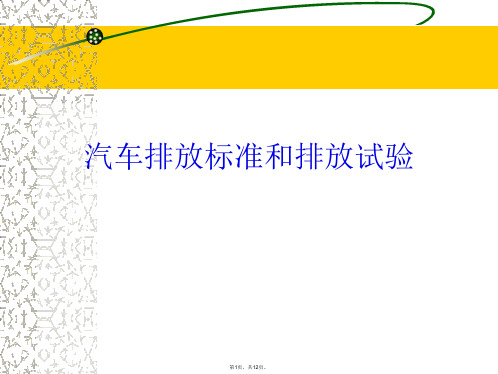
单位 g/km g/test g/km g/test
四、我国汽车排放标准
我国制定汽车排放标准时间较晚,这主要因为我国汽车保
有量在过去较少,人们没意识到控制汽车排放污染的必要性。
但从90年代开始我国汽车保有量急剧增加,汽车排气污染日趋
严重。于是80年代末,我国开始制定汽车排放标准。
自1983年开始,我国相继颁布的汽油车排放标准有: ①汽油机怠速污染物排放标准(GB3842—83)。
乘用车
5
10
GVW≤
5
轻 3750lb
型s
10
货 GVW≥
5
车 3750lb
s
10
THC
NMH C
CO
NOx
PM
0.41 0.25 3.4 0.4 0.08
----- 0.31 4.2 0.6 0.10
0.80 0.25 3.4 0.4 0.08
----- 0.31 4.2 0.6 0.10
0.80 0.32 4.4 0.7 0.08
5)1965年起,颁布了汽车内燃机空气污染控制法规;
6)1966—1967年,颁布了限止汽车废气中CO、HC的具体值 及试验工况设置,根据特定的运行工况将CO和HC的最高含量确 定为1.51%和275PPm;
7)1968--1969年,根据内燃机排量对排放中的CO、HC的限
值进行修改,修改值见表6--1。
1.7t< GVW≥2.5t
实验工况
10、15 11
10、15 11
排放限值
HC 0.25(0.39)
7.0(9.5)
CO 2.1(2.7) 60(85)
NOx
0.25(0.4 8)
4.4(6.0)
- 1、下载文档前请自行甄别文档内容的完整性,平台不提供额外的编辑、内容补充、找答案等附加服务。
- 2、"仅部分预览"的文档,不可在线预览部分如存在完整性等问题,可反馈申请退款(可完整预览的文档不适用该条件!)。
- 3、如文档侵犯您的权益,请联系客服反馈,我们会尽快为您处理(人工客服工作时间:9:00-18:30)。
美国汽车排放标准
美国有加州及联邦两个标准。
美国加州最早控制汽车排放,而且标准也最严。
1963年制订了“大气清洁法”;1966年加州制订“7工况法”,颁布汽车排放控制标准;1968年联邦采用“7工况法”开始控制汽车排放;1972年联邦采用LA-4C(FTP-72)试验规范,并增加对NO X的控制;1975年改用LA-4H(FTP-75),并一直延续使用至今。
1975年起到80年代,美国排放标准大幅度加严,特别强化对NO X的限值,同时再提高对HC和CO的控制,1983年排放标准一直维持到1993年。
1990年美国国会修订了“清洁空气法”,对汽车排放提出更加严格的要求。
表11-1是联邦轿车排放标准。
联邦分两阶段加严排放标准,对HC的排放限制不仅指总碳氢(THC),而要限制非甲烷碳氢化物(NMHC),另外新标准增加对排放稳定性(使用寿命)的考核,提出8万英里和16万英里两个排放限值(见表11-2)。
美国联邦轻型车排放控制标准(g/mile) 表11-1
美国轻型汽车排放限值(FTP-75测试循环) (g/km) 表11-2
(1)微粒排放只用于柴油车
1994年加州颁布了清洁燃料和低排放汽车计划CF/LEV,规定从1995年起实施严格的低污染汽车标准(LEV),分四阶段进行:即过渡低排放车(TLEV)、低排放车(LEV)、超低排放车(ULEV)和零污染车和(ZEV)。
表11-3是加州轿车排放限值。
美国加州轻型汽车排放限值(g/km) 保证里程80000km
表11-3
美国联邦49个州和加利福尼亚州的重型车用柴油机的排放限值见表11-4。
美国重型车用柴油机的排放。
